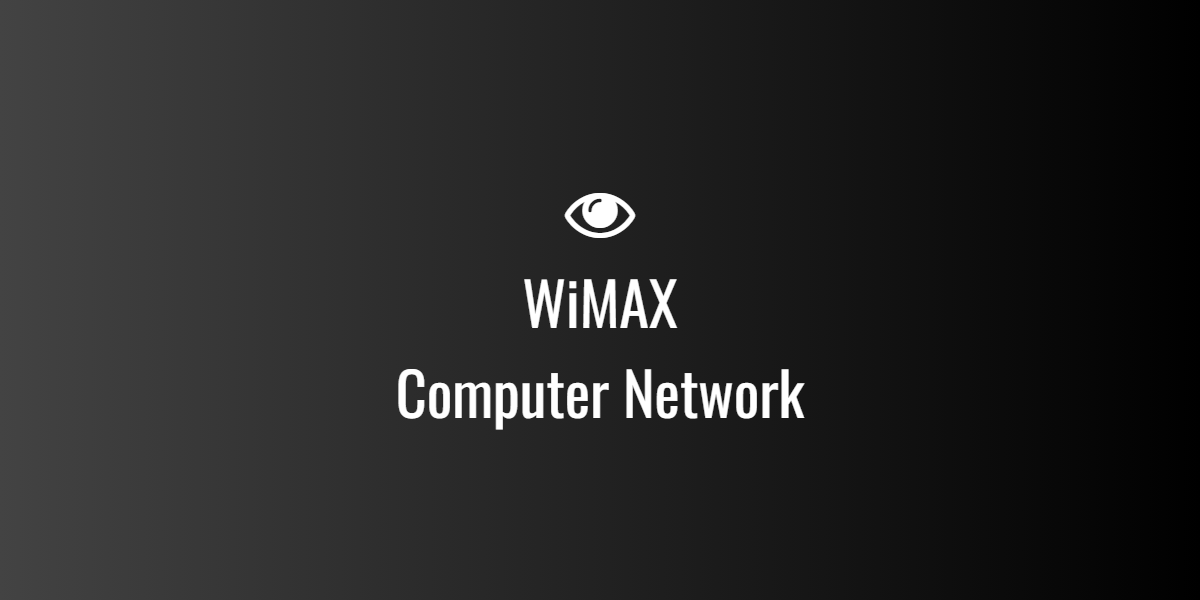
WiMAX Computer Network
WiMAX (Worldwide Interoperability for Microwave Access) is a wireless communication technology that provides high-speed broadband internet access over a wide geographical area. It is a standardized protocol based on the IEEE 802.16 family of standards. WiMAX is often compared to Wi-Fi, but unlike Wi-Fi, which operates over short distances (typically within a home or office), WiMAX can provide long-range internet access with speeds comparable to wired broadband.
WiMAX was developed to offer broadband wireless access (BWA) for fixed and mobile networks, making it ideal for regions where traditional broadband infrastructure is not available or where high-speed data needs to be transmitted over long distances.
Key Features of WiMAX
- High-Speed Data Transmission:
- WiMAX supports high data rates ranging from 2 Mbps to 1 Gbps, depending on the configuration and use case. It allows for both uplink (upload) and downlink (download) transmission, with the maximum download speeds reaching up to 1 Gbps for fixed connections and 40 Mbps for mobile connections.
- Wide Coverage Area:
- WiMAX can cover a large geographic area, typically up to 50 km (in ideal conditions) for fixed broadband services, and around 5-15 km for mobile services. This makes it an ideal solution for providing broadband in rural or remote areas where traditional wired broadband is difficult or expensive to deploy.
- High Capacity:
- WiMAX is designed to handle high-capacity communication, making it suitable for densely populated areas as well as high-demand applications. It can support multiple users within the same area by using techniques like multiple-input multiple-output (MIMO) and adaptive modulation.
- Mobile and Fixed Applications:
- WiMAX supports both fixed (stationary) and mobile (mobile devices like smartphones and laptops) configurations. For mobile WiMAX (often referred to as IEEE 802.16e), the technology allows users to stay connected while moving.
- Quality of Service (QoS):
- WiMAX provides Quality of Service (QoS) mechanisms to prioritize certain types of traffic, such as video conferencing, voice over IP (VoIP), and streaming media. This ensures that high-priority applications get the necessary bandwidth, even in network congestion.
- Scalability:
- WiMAX can be deployed in a variety of scenarios, including point-to-point, point-to-multipoint, and mesh network configurations. This scalability allows WiMAX to cater to a wide range of applications, from wireless broadband to backhaul services.
- Security:
- WiMAX supports strong security mechanisms, such as encryption, authentication, and data integrity, to protect user data and prevent unauthorized access. The security architecture is based on the Advanced Encryption Standard (AES) and mutual authentication.
- Efficiency:
- WiMAX uses advanced techniques like orthogonal frequency-division multiplexing (OFDM) to achieve high spectral efficiency and reduce interference. This enables efficient data transmission even in harsh environmental conditions.
WiMAX Architecture
WiMAX networks generally consist of the following components:
- Subscriber Station (SS):
- The subscriber station is the device that connects to the WiMAX network. It could be a laptop, smartphone, fixed wireless modem, or any other device that connects to a WiMAX base station.
- Base Station (BS):
- The base station provides wireless coverage and communicates with the subscriber stations. It manages the radio interface and acts as the connection point to the core network. The base station typically communicates with multiple SSs within its coverage area.
- Access Service Network (ASN):
- The ASN is responsible for managing and maintaining the radio access network. It provides bandwidth allocation, manages handover procedures (for mobile stations), and handles QoS mechanisms.
- Connectivity Service Network (CSN):
- The CSN is the backbone of the WiMAX network. It connects the ASN to the internet or any other external network. It also manages authentication, billing, and service control for users.
- WiMAX Hub:
- A WiMAX hub serves as a central point for managing communication between different base stations. It facilitates communication and data transfer over the larger network.
WiMAX Protocols and Standards
WiMAX is based on several IEEE 802.16 standards. Here are the key standards:
- IEEE 802.16:
- This is the original standard for WiMAX and specifies the physical layer (PHY) and medium access control (MAC) layer for broadband wireless access networks.
- IEEE 802.16e (Mobile WiMAX):
- The IEEE 802.16e standard is an extension of the original 802.16 standard that supports mobility. It enables devices to remain connected while moving, making it suitable for mobile applications.
- IEEE 802.16m:
- This is an updated version of the standard designed to improve performance and support high-speed mobile applications (e.g., LTE-like speeds). It provides higher throughput, improved security, and supports advanced techniques like MIMO.
- IEEE 802.16d:
- This standard provides guidelines for fixed WiMAX networks, focusing on static devices, such as desktop computers, that are connected to the network.
WiMAX vs. LTE
While both WiMAX and LTE (Long Term Evolution) are 4G wireless broadband technologies, they differ in several key areas:
| Feature | WiMAX | LTE |
|---|---|---|
| Speed | Up to 1 Gbps (fixed) and 40 Mbps (mobile) | Up to 1 Gbps (downlink) and 100 Mbps (uplink) |
| Deployment | Primarily for fixed and mobile broadband | Primarily for mobile broadband |
| Coverage | 50 km (fixed), 5-15 km (mobile) | Generally 2-5 km (urban) and up to 100 km (rural) |
| Mobility | Supports mobility (IEEE 802.16e) | Highly mobile with seamless handovers |
| Latency | Lower latency for fixed connections | Lower latency overall for both fixed and mobile |
| Ecosystem | Less widespread deployment | Broadly adopted, with global 4G rollout |
| Technology | Based on OFDM and MIMO | Based on OFDMA (Orthogonal Frequency Division Multiple Access) |
Use Cases of WiMAX
WiMAX is designed for various broadband applications and can be used in:
- Rural and Remote Areas:
- WiMAX is an excellent solution for providing internet access to remote and underserved regions where laying cables for traditional broadband services (like DSL or fiber) is impractical or too costly.
- Urban and Suburban Areas:
- WiMAX can provide wireless broadband to densely populated urban areas, offering competitive internet speeds and alternative solutions for areas with high demand.
- Mobile Internet Access:
- With its support for mobile applications (via IEEE 802.16e), WiMAX allows for mobile broadband access, enabling users to stay connected while traveling.
- Backhaul Networks:
- WiMAX can be used to create high-capacity backhaul networks, providing wireless links between remote base stations and central network infrastructure.
- Business Connectivity:
- WiMAX can provide reliable, high-speed internet connectivity for businesses, enabling video conferencing, cloud applications, and other business-critical services.
- Private Networks:
- WiMAX can be used to create private networks for enterprises, educational institutions, and government organizations, providing secure and efficient data transmission.
Advantages of WiMAX
- High-Speed Broadband:
- WiMAX provides high-speed internet access, offering speeds that can rival those of wired broadband technologies.
- Wide Coverage:
- WiMAX supports a wide coverage range (up to 50 km) for fixed access, making it ideal for remote and rural areas.
- Flexibility:
- It can be used for both fixed and mobile applications, providing flexibility in deployment.
- Cost-Effective:
- Deploying WiMAX is often more cost-effective than laying fiber or cables, particularly in regions where the infrastructure is lacking.
- Scalable:
- WiMAX networks can be easily scaled to handle increasing demand by adding additional base stations or expanding coverage areas.
Disadvantages of WiMAX
- Limited Adoption:
- While WiMAX was initially considered a leading 4G technology, it has been largely overshadowed by LTE in recent years. LTE has become more widely adopted, particularly in mobile networks.
- Deployment Costs:
- Although WiMAX is cheaper than fiber, the cost of setting up base stations and managing the network can still be significant for service providers.
- Interference Issues:
- Like all wireless technologies, WiMAX can be susceptible to interference from other devices, weather conditions, and physical obstacles that affect signal quality.
- Limited Ecosystem:
- While WiMAX has seen success in some regions, its ecosystem is smaller than LTE’s, which limits the variety of compatible devices and infrastructure.
Conclusion
WiMAX was once considered a leading contender for wireless broadband access, especially for providing high-speed internet in remote or underserved areas. While its adoption has been overshadowed by LTE in many regions, it still offers valuable solutions for fixed and mobile broadband, particularly in rural and regional markets. With its wide coverage, high-speed capabilities, and scalability, WiMAX remains a useful technology in the global quest for affordable and efficient internet access.




